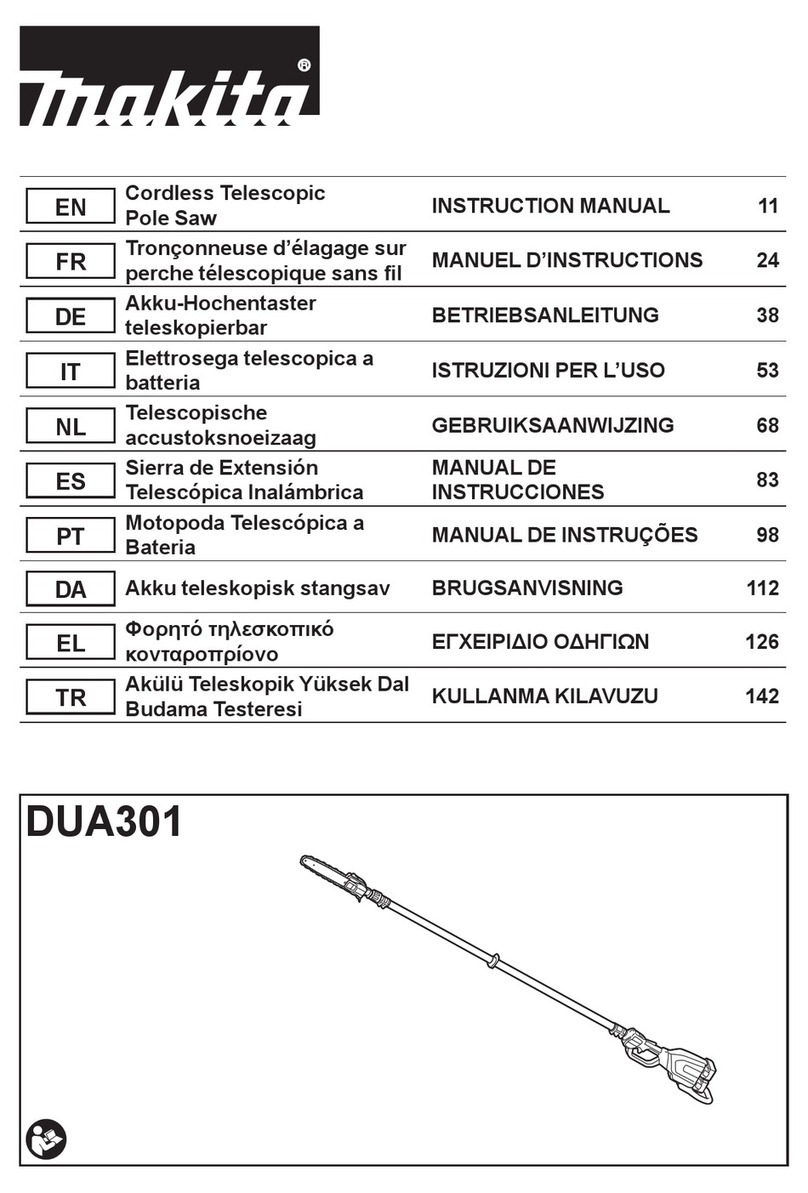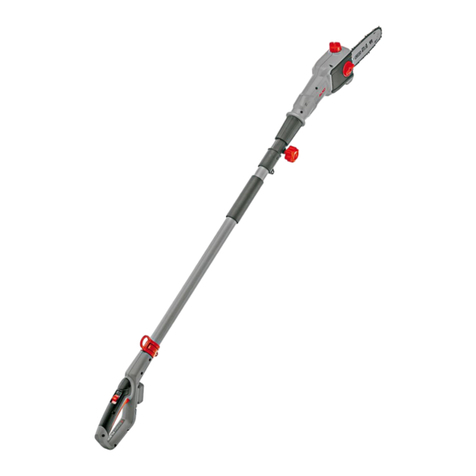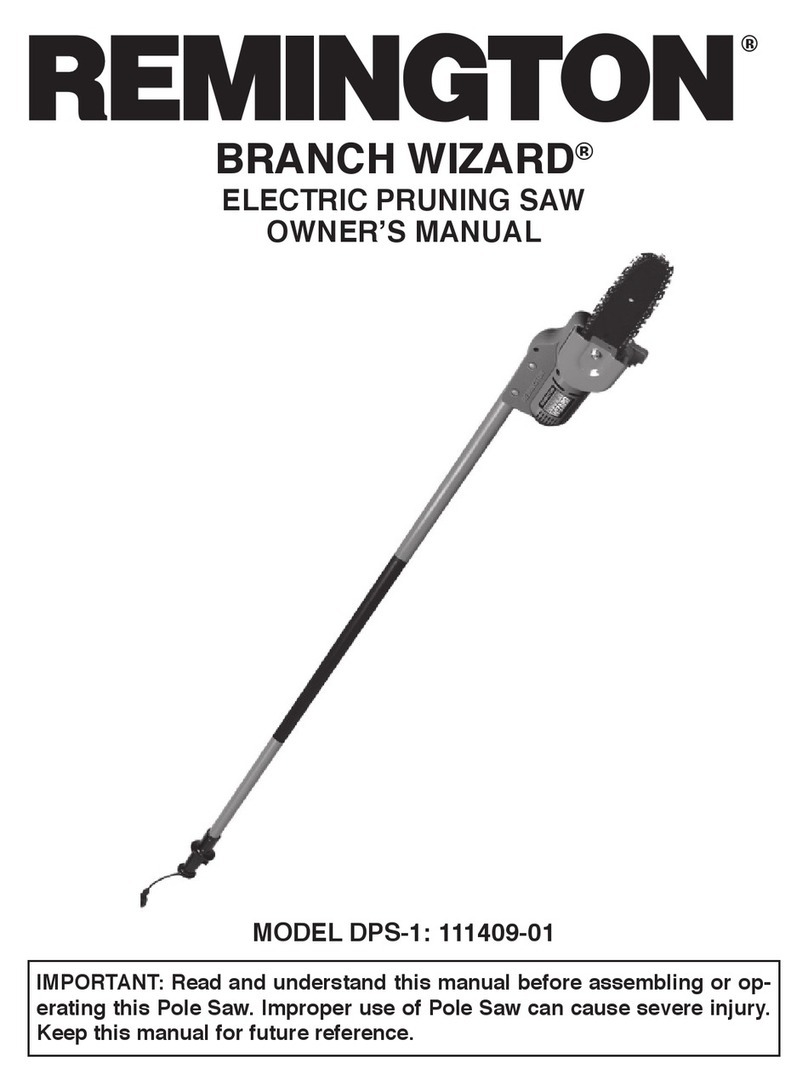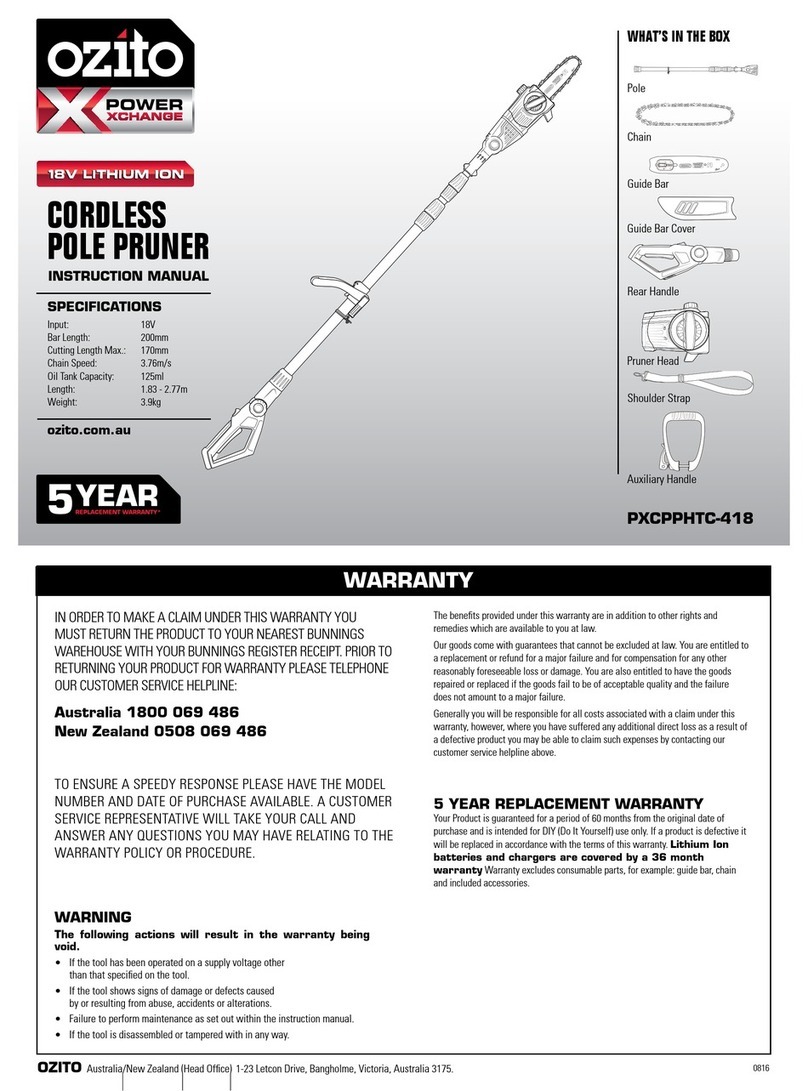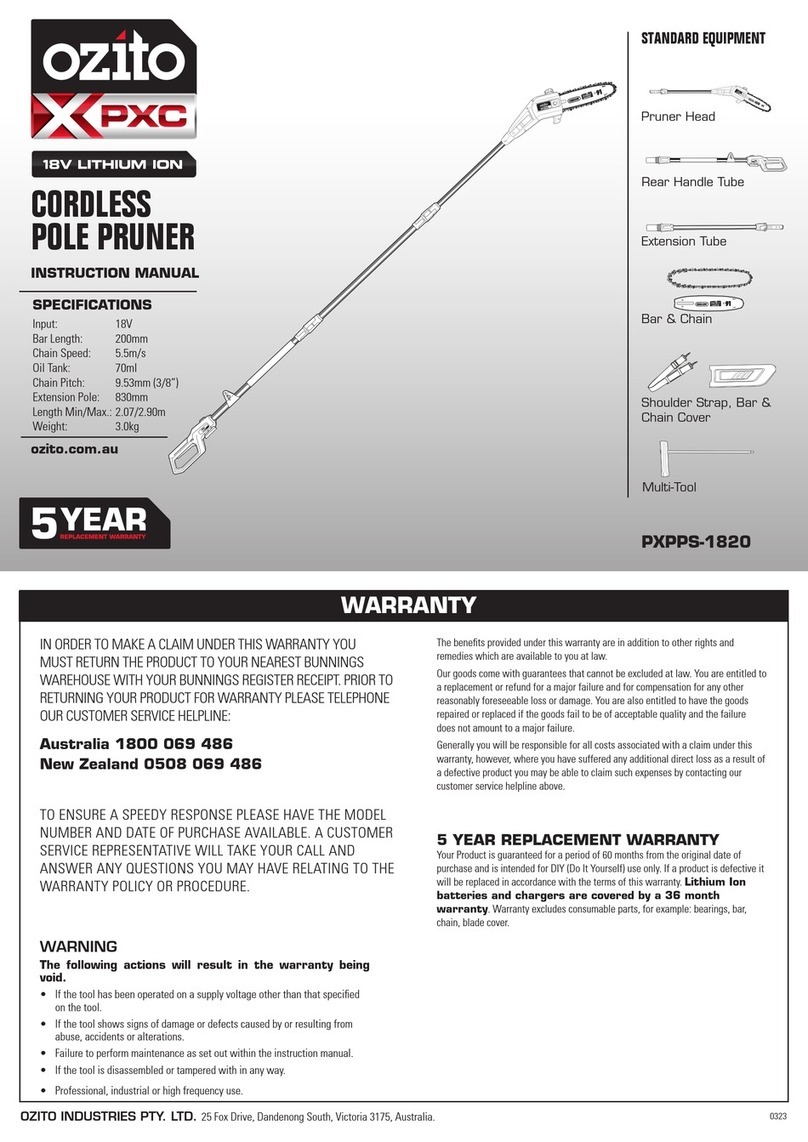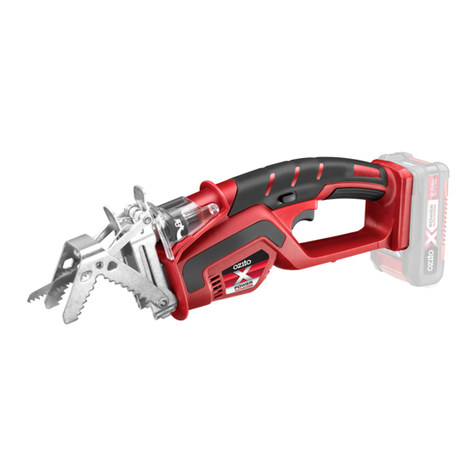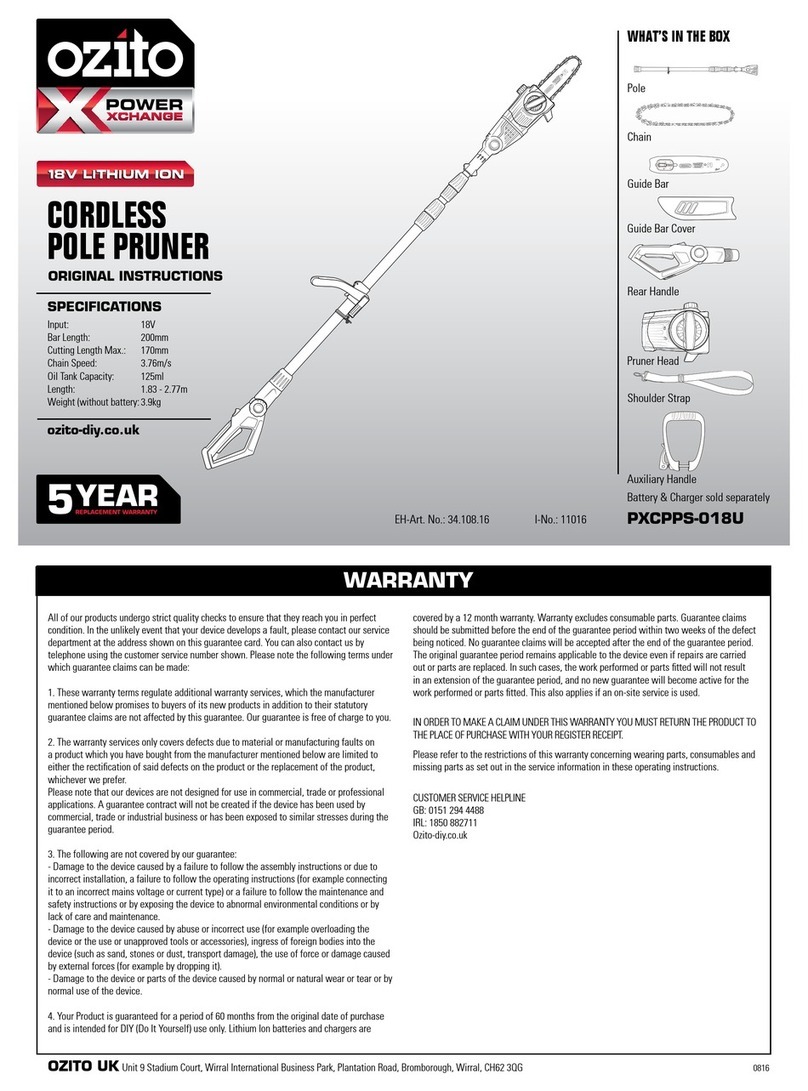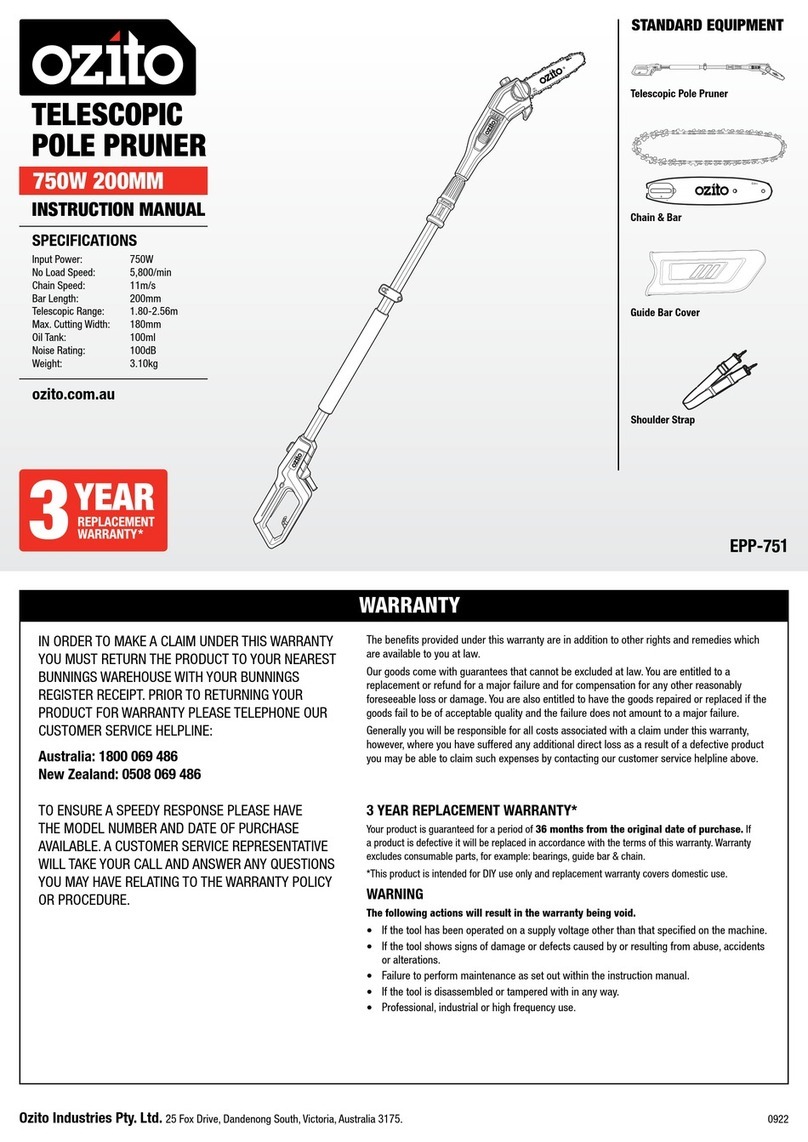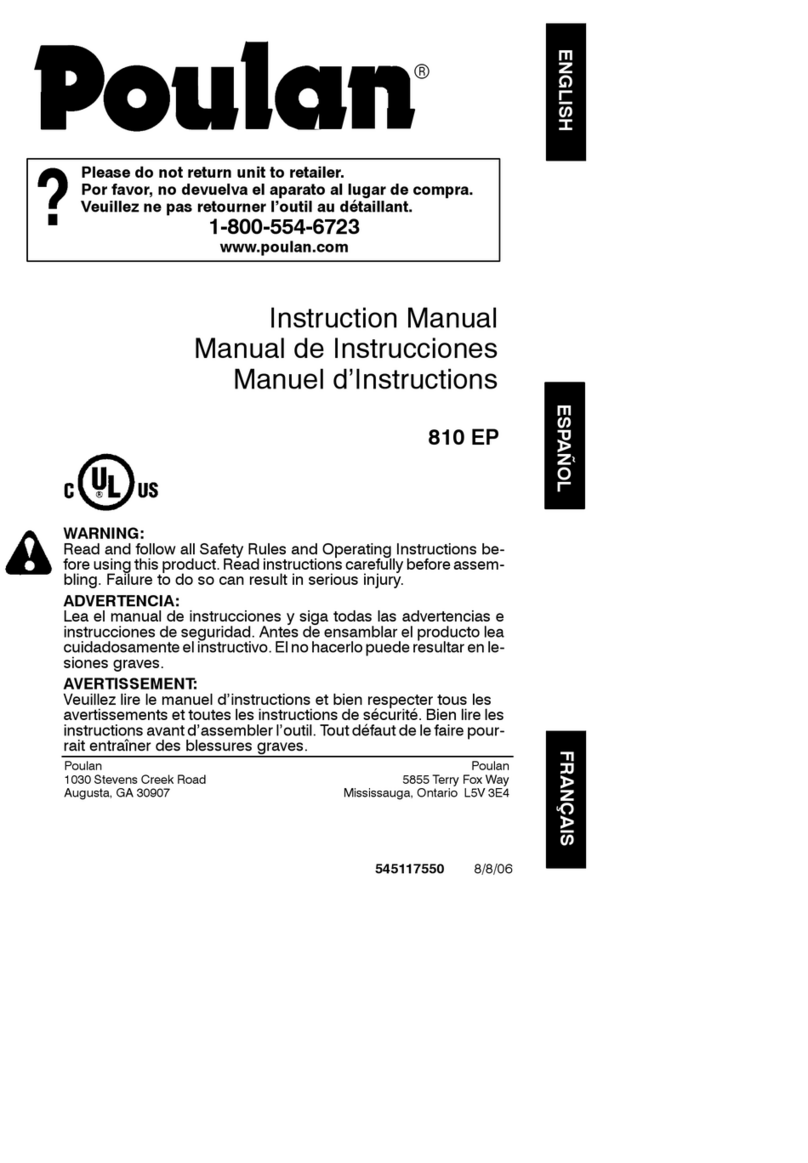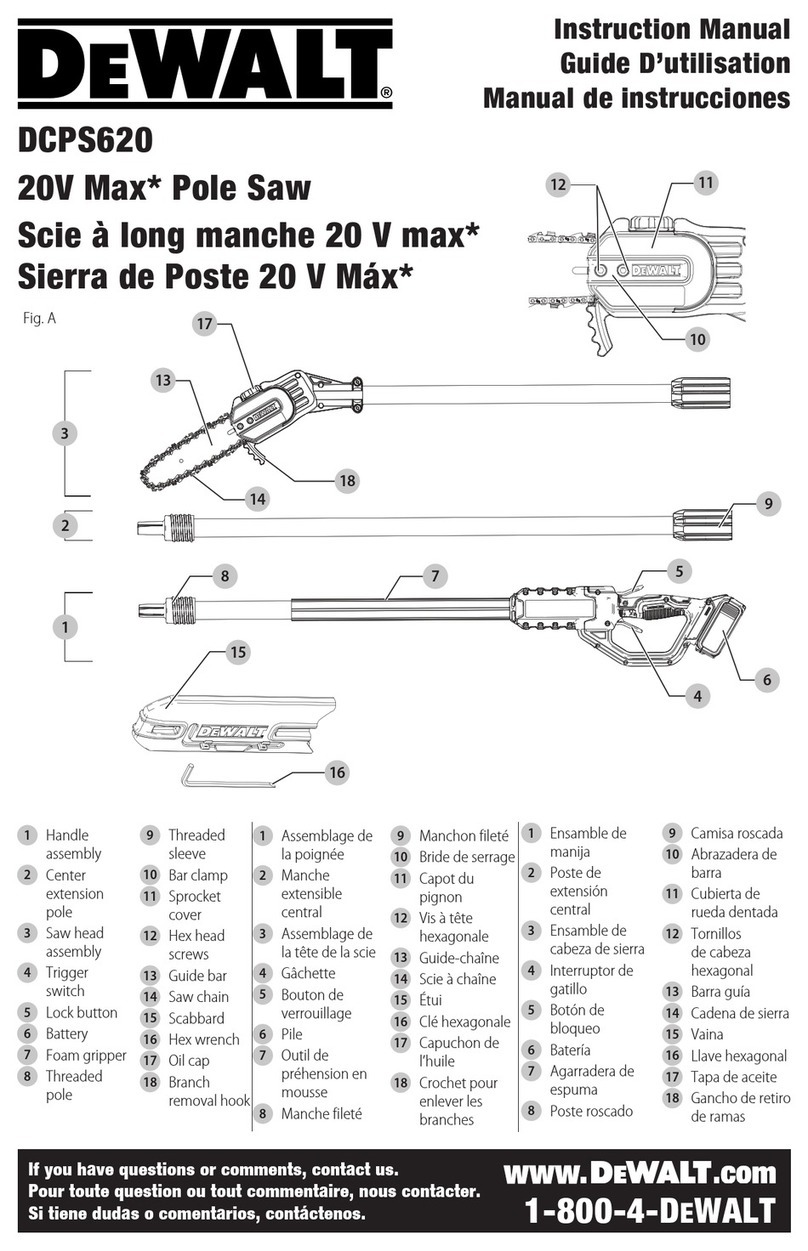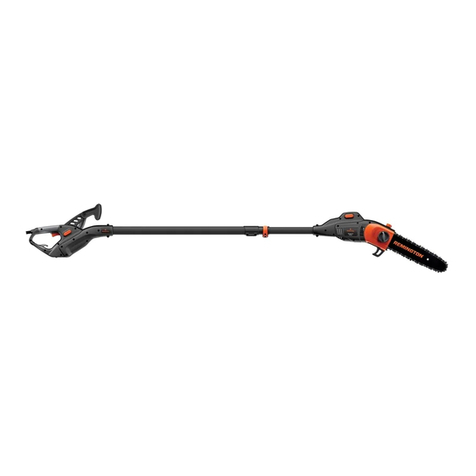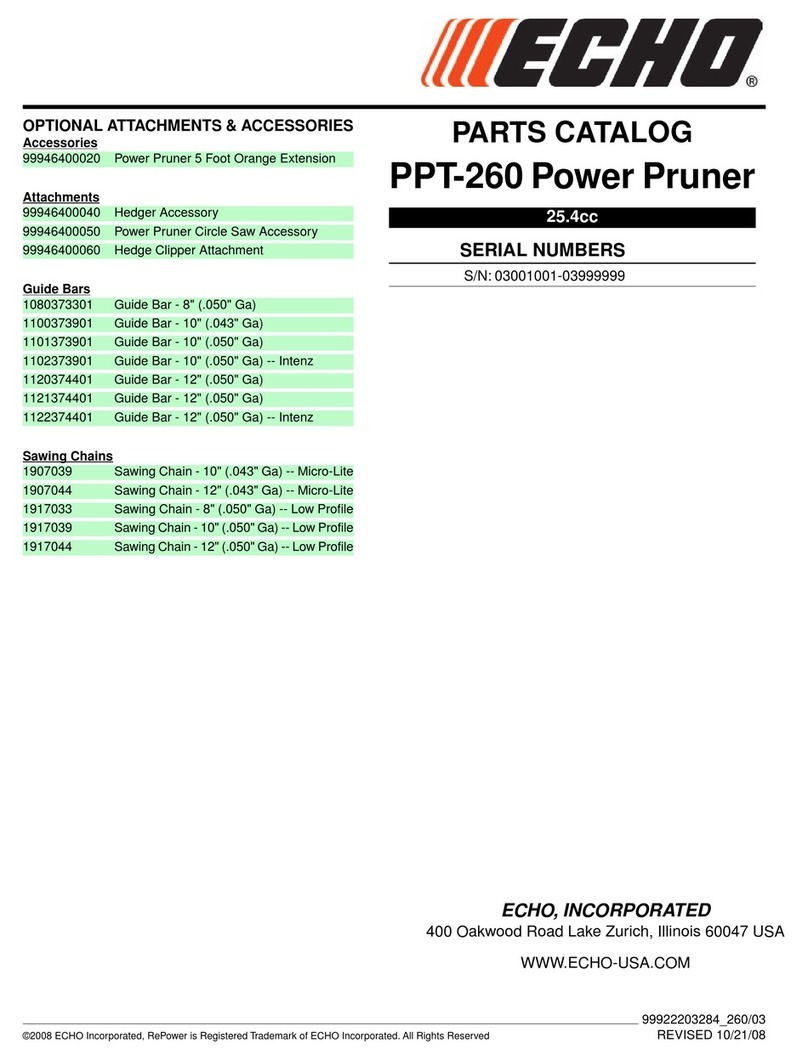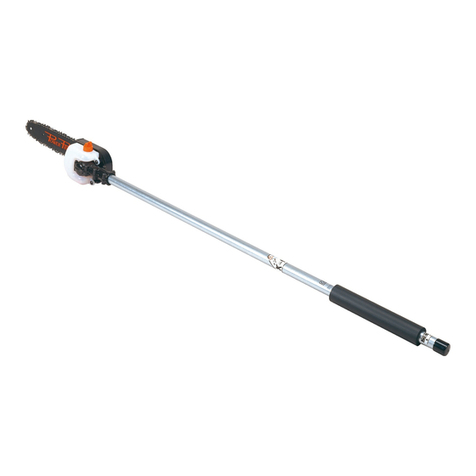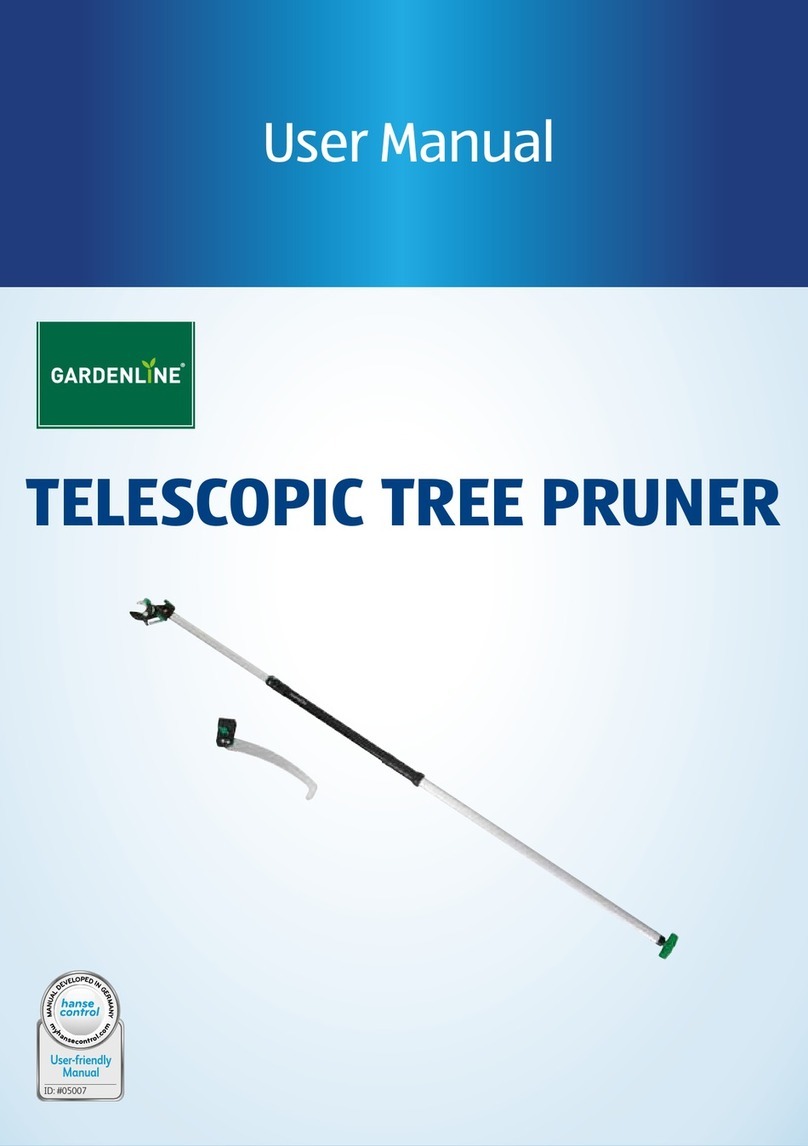• When removing branches,
hold the pruner at an angle
ranging from a maximum 60°
to horizontal in order to avoid
being struck by a falling branch.
• Saw off the lower branches on
the tree rst. By doing so, it is
easier for the cut branches to
fall to the ground.
• Do not saw with the tip of the
guide bar. This could lead to
kick back and possible injury
• At the end of the cut, the
weight of the pruner suddenly
increases for the user, because
it is no longer supported on
the branch. There is the risk of
losing control of the pruner.
• Only pull the pruner out of the
cut with the chain running. By
doing so, you can prevent it
from getting jammed.
Limbing
Limbing is the process of
removing the branches from a
fallen tree. Check the direction
in which a branch will bend
before cutting it. Always cut
on the opposite side to the
bending direction so that the
guide bar is not pinched in
the cut. For large limbs that
cannot be removed in one cut, make an
initial cut from the bent side and nish by
sawing from the opposite direction. Do not
remove limbs that are supporting the fallen
tree on the ground until the tree has been
cut into lengths.
Pruning
Pruning is the removal of a limb
or branch from a standing tree.
TELESCOPIC
POLE PRUNER
750W 200MM (8”)
INSTRUCTION MANUAL
SPECIFICATIONS
Power: 750W
Voltage: 230 - 240Volt ~ 50Hz
Chain Speed: 11 meters /second
No Load Speed: 6,000 min-¹
Max Cutting Width: 180mm
Guide Bar Length: 200mm (8”)
Oil Tank Capacity: 60 ml
Telescopic Range: 165 – 252cm
Net Weight: 3.50kgs
PPE-750
WHAT’S IN THE BOX
IN ORDER TO MAKE A CLAIM UNDER THIS
WARRANTY YOU MUST RETURN THE PRODUCT
TO YOUR NEAREST BUNNINGS WAREHOUSE WITH
YOUR BUNNINGS REGISTER RECEIPT. PRIOR TO
RETURNING YOUR PRODUCT FOR WARRANTY
PLEASE TELEPHONE OUR CUSTOMER SERVICE
HELPLINE:
Australia 1800 069 486
New Zealand 0508 069 486
2 YEAR REPLACEMENT WARRANTY
Your product is guaranteed for a period of 24 months from
the original date of purchase. If a product is defective it will
be replaced in accordance with the terms of this warranty.
Warranty excludes consumable parts, for example:
guide bar, chains and included accessories.
WARNING
The following actions will result in the warranty being void.
• Professional, Industrial or high frequency use.
• If the tool shows signs of damage or defects caused
by or resulting from abuse, accidents or alterations.
• Failure to perform maintenance as set out within the
instruction manual.
• If the tool is disassembled or tampered with in any way.
This appliance is not intended for use by persons (including children) with reduced physical,
sensory or mental capabilities, or lack of experience and knowledge, unless they have been given
supervision or instruction concerning use of the appliance by a person responsible for their safety.
Young children should be supervised to ensure that they do not play with the appliance.
Recommendations for the use of a residual current device with a rated residual current of 30mA
or less.
• Keep all parts of the body away from the saw chain when the chain saw is operating.
Before you start the chain saw, make sure the saw chain is not contacting anything. A
moment of inattention while operating chain saws may cause entanglement of your clothing or
body with the saw chain.
• Always hold the chain saw with your right hand on the rear handle and your left hand on
the front handle. Holding the chain saw with a reversed hand conguration increases the risk
of personal injury and should never be done.
• Wear safety glasses and hearing protection. Further protective equipment for head,
hands, legs and feet is recommended. Adequate protective clothing will reduce personal
injury by ying debris or accidental contact with the saw chain.
• Do not operate a chain saw in a tree. Operation of a chain saw while up in a tree may result in
personal injury.
• Always keep proper footing and operate the chain saw only when standing on xed,
secure and level surface. Slippery or unstable surfaces such as ladders may cause a loss of
balance or control of the chain saw.
• When cutting a limb that is under tension be alert for spring back. When the tension in the
wood bres is released the spring loaded limb may strike the operator and/or throw the chain
saw out of control.
• Use extreme caution when cutting brush and saplings. The slender material may catch the
saw chain and be whipped toward you or pull you off balance.
• Carry the chain saw by the front handle with the chain saw switched off and away from
your body. When transporting or storing the chain saw always t the guide bar cover.
Proper handling of the chain saw will reduce the likelihood of accidental contact with the
moving saw chain.
• Follow instructions for lubricating, chain tensioning and changing accessories.
Improperly tensioned or lubricated chain may either break or increase the chance for kickback.
• Keep handles dry, clean, and free from oil and grease. Greasy, oily handles are slippery
causing loss of control.
• Cut wood only. Do not use chain saw for purposes not intended. For example: do not use
chain saw for cutting plastic, masonry or non-wood building materials. Use of the chain
saw for operations different than intended could result in a hazardous
Kickback
Kickback may occur when the nose or tip of the guide bar touches an object, or when the
wood closes in and pinches the saw chain in the cut.
Tip contact in some cases may cause a sudden reverse reaction, kicking the guide bar up and back
towards the operator.
Pinching the saw chain along the top of the guide bar may push the guide bar rapidly back towards
the operator.
Either of these reactions may cause you to lose control of the saw which could result in serious
personal injury. Do not rely exclusively upon the safety devices built into your saw. As a chain
saw user, you should take several steps to keep your cutting jobs free from accident or injury.
Kickback is the result of tool misuse and/or incorrect operating procedures or conditions and can be
avoided by taking proper precautions as given below:
• Maintain a rm grip, with thumbs and ngers encircling the chain saw handles, with both hands
on the saw and position your body and arm to allow you to resist kickback forces. Kickback
forces can be controlled by the operator, if proper precautions are taken. Do not let go of the
chain saw.
• Do not overreach and do not cut above shoulder height. This helps prevent unintended tip
contact and enables better control of the chain saw in unexpected situations.
• Only use replacement bars and chains specied by the manufacturer. Incorrect replacement
bars and chains may cause chain breakage and/or kickback.
• Follow the manufacturer’s sharpening and maintenance instructions for the saw chain.
Decreasing the depth gauge height can lead to increased kickback.
Push Back
Push back will occur if an attempt is made to saw with the top of the guide bar, if the chain touches
against a rigid object and jams in the cut.
Pull Forward
If the bucking spikes are not set against the timber, the chain at the bottom of the guide bar will
pull the saw forward; this can jam the chain in the timber.
To avoid this always have the bucking spikes set against the timber when performing
a cut.
WARRANTY
TO ENSURE A SPEEDY RESPONSE PLEASE
HAVE THE MODEL NUMBER AND DATE OF
PURCHASE AVAILABLE. A CUSTOMER SERVICE
REPRESENTATIVE WILL TAKE YOUR CALL
AND ANSWER ANY QUESTIONS YOU MAY
HAVE RELATING TO THE WARRANTY POLICY
OR PROCEDURE.
OZITO Australia/NewZealand(HeadOfce) 1-23 Letcon Drive, Bangholme, Victoria, Australia 3175.
Thebenetsprovidedunderthiswarrantyareinaddition
to other rights and remedies which are available to you at law.
Our goods come with guarantees that cannot be excluded
at law. You are entitled to a replacement or refund for a major
failure and for compensation for any other reasonably foreseeable
loss or damage. You are also entitled to have the goods repaired
or replaced if the goods fail to be of acceptable quality and the
failure does not amount to a major failure.
Generally you will be responsible for all costs associated with
a claim under this warranty, however, where you have suffered
any additional direct loss as a result of a defective product you
may be able to claim such expenses by contacting our customer
service helpline above.
ozito.com.au
Chain sharpening
Sharpen the chain regularly to maintain optimum performance
of the pole pruner.
Signs of a dull chain are:
• The sawdust becomes powder-like
• Extra force is required to
execute a cut
• The cut does not track
in a straight line
• Increased vibration
Sharpen each cutter using a chain le.
Always use outward strokes and maintain
a 30° angle between the chain and le.
After sharpening, the cutters must all have
the same width and length.
Guide bar wear
Reverse the guide bar every 8 working hours to ensure uniform wear.
Check the guide rails frequently and if necessary remove burrs and
square up the rails using a at le.
Cleaning and storage
• Regularly clean the tensioning mechanism by blowing compressed
air onto or cleaning it with a brush. Do not use any tools for the
cleaning.
• Keep oil away from the handle in order to ensure a secure hold.
• Clean the machine as necessary with a damp cloth and a mild
cleanser, if appropriate.
• If the pole pruner is not used for an extended period of time,
remove the chain and bar oil from the tank. Briey place the chain
and the guide bar in an oil bath and then wrap it in oil paper.
• Always replace the protective cover for transport or storage of the
pole pruner.
• Pull out the electrical plug before cleaning.
• Never immerse the machine in water or other liquids.
• Store the pole pruner in a safe and dry place and out of the
reach of children.
Note: The pole pruner warranty does not cover components that have
been subjected to operator abuse or negligence. To receive full value
from the warranty, the operator must maintain the pole pruner as
instructed in this manual.
Ozito Industries will not be responsible for any damage or
injuries caused by repair of the tool by an unauthorised person
or mishandling or mistreatment of the tool. This tool is designed
for Domestic Home Use only. Use in commercial or industrial
environments will void the warranty.
WARNING!: WEAR HEAVY GLOVES WHEN
HANDLING THE CHAIN. HOLD THE GUIDE BAR
SECURELY IN A VICE.
WARNING! When using mains-powered tools, basic safety precautions, including
the following, should always be followed to reduce risk of re, electric shock,
personal injury and material damage.
Read the whole manual carefully and make sure you know how to switch the tool off in an
emergency, before operating the tool.
Save these instructions and other documents supplied with this tool for future reference.
The electric motor has been designed for 230V and 240V only. Always check that the power supply
corresponds to the voltage on the rating plate.
Note: The supply of 230V and 240V on Ozito tools are interchangeable for Australia and New
Zealand.
This tool is double insulated in accordance with AS/NZS 60745-1;
therefore no earth wire is required.
If the supply cord is damaged, it must be replaced by an electrician or a power tool repairer in order
to avoid a hazard.
Note: Double insulation does not take the place of normal safety precautions when operating this
tool. The insulation system is for added protection against injury resulting from a possible electrical
insulation failure within the tool.
Using an Extension Lead
Always use an approved extension lead suitable for the power input of this tool. Before use, inspect
the extension lead for signs of damage, wear and ageing. Replace the extension lead if damaged
or defective.
When using an extension lead on a reel, always unwind the lead completely. Use of an extension
lead not suitable for the power input of the tool or which is damaged or defective may result in a risk
of re and electric shock.
WARNING! Read all safety warnings and all instructions. Failure to follow the
warnings and instructions may result in electric shock, re and/or serious injury. Save all
warnings and instructions for future reference. The term “power tool” in the warnings
refers to your mains-operated (corded) power tool or battery-operated (cordless) power tool.
SAVE THESE INSTRUCTIONS.
1. Work area safety
a. Keep work area clean and well lit. Cluttered or dark areas invite accidents.
b. Do not operate power tools in explosive atmospheres, such as in the presence of ammable
liquids, gases or dust. Power tools create sparks which may ignite the dust or fumes.
c. Keep children and bystanders away while operating a power tool. Distractions can cause
you to lose control.
2. Electrical safety
a. Power tool plugs must match the outlet. Never modify the plug in any way.
Do not use any adapter plugs with earthed (grounded) power tools. Unmodied plugs and
matching outlets will reduce risk of electric shock.
b. Avoid body contact with earthed or grounded surfaces, such as pipes, radiators, ranges
and refrigerators. There is an increased risk of electric shock if your body is earthed or grounded.
c. Do not expose power tools to rain or wet conditions. Water entering a power tool will
increase the risk of electric shock.
d. Do not abuse the cord. Never use the cord for carrying, pulling or unplugging the power
tool. Keep cord away from heat, oil, sharp edges or moving parts. Damaged or entangled
cords increase the risk of electric shock.
e. When operating a power tool outdoors, use an extension cord suitable for outdoor use.
Use of a cord suitable for outdoor use reduces the risk of electric shock.
f. If operating a power tool in a damp location is unavoidable, use a residual current device
(RCD) protected supply. Use of an RCD reduces the risk of electric shock.
3. Personal safety
a. Stay alert, watch what you are doing and use common sense when operating a power
tool. Do not use a power tool while you are tired or under the inuence of drugs, alcohol
or medication. A moment of inattention while operating power tools may result in serious
personal injury.
b. Use personal protective equipment. Always wear eye protection. Protective equipment
such as dust mask, non-skid safety shoes, hard hat, or hearing protection used for appropriate
conditions will reduce personal injuries.
c. Prevent unintentional starting. Ensure the switch is in the off-position before connecting
to power source and/or battery pack, picking up or carrying the tool. Carrying power tools
with your nger on the switch or energising power tools that have the switch on invites accidents.
d. Remove any adjusting key or wrench before turning the power tool on. A wrench or a key
left attached to a rotating part of the power tool may result in personal injury.
e. Do not overreach. Keep proper footing and balance at all times. This enables better control
of the power tool in unexpected situations.
f. Dress properly. Do not wear loose clothing or jewellery. Keep your hair, clothing and gloves
away from moving parts. Loose clothes, jewellery or long hair can be caught in moving parts.
g. If devices are provided for the connection of dust extraction and collection facilities, ensure
these are connected and properly used. Use of dust collection can reduce dust-related hazards.
4. Power tool use and care
a. Do not force the power tool. Use the correct power tool for your application. The correct
power tool will do the job better and safer at the rate for which it was designed.
b. Do not use the power tool if the switch does not turn it on and off. Any power tool that
cannot be controlled with the switch is dangerous and must be repaired.
c. Disconnect the plug from the power source and/or the battery pack from the power tool
before making any adjustments, changing accessories, or storing power tools. Such
preventive safety measures reduce the risk of starting the power tool accidentally.
d. Store idle power tools out of the reach of children and do not allow persons unfamiliar
with the power tool or these instructions to operate the power tool. Power tools are
dangerous in the hands of untrained users.
e. Maintain power tools. Check for misalignment or binding of moving parts, breakage of parts
and any other condition that may affect the power tool’s operation. If damaged, have the
power tool repaired before use. Many accidents are caused by poorly maintained power tools.
f. Keep cutting tools sharp and clean. Properly maintained cutting tools with sharp cutting edges
are less likely to bind and are easier to control.
g. Use the power tool, accessories and tool bits etc. in accordance with these instructions,
taking into account the working conditions and the work to be performed. Use of the power
tool for operations different from those intended could result in a hazardous situation.
5. Service
a. Have your power tool serviced by a qualied repair person using only identical
replacement parts. This will ensure that the safety of the power tool is maintained.
b. If the supply cord is damaged, it must be replaced by the manufacturer,
its service agent or similarly qualied persons in order to avoid a hazard.
GENERAL POWER TOOL SAFETY WARNINGS
ELECTRICAL SAFETY
Shoulder Strap
Telescopic Pole Pruner
Chain
Guide Bar
Guide Bar Cover
Hex Key
WARNING!: IF THE CHAIN COMES IN CONTACT
WITH A HARD OBJECT, VISUALLY INSPECT THE
CHAIN & BAR FOR DAMAGE. IF THE CHAIN OR BAR IS
DAMAGED, DO NOT CONTINUE TO OPERATE THE POLE
PRUNER.
WARNING! NEVER USE THE POLE PRUNER WHEN
STANDING ON A LADDER OR UNEVEN GROUND.
DO NOT OVERREACH. ALWAYS USE BOTH HANDS TO
HOLD THE POLE PRUNER.
IMPORTANT! BEFORE CLEANING YOUR POLE PRUNER
OR CARRYING OUT ANY MAINTENANCE PROCEDURE,
MAKE SURE THAT THE MOTOR IS OFF AND THE TOOL
DISCONNECTED FROM THE POWER SUPPLY
TO PREVENT ACCIDENTAL STARTING.
7. APPLICATIONS 8. SAWING TECHNIQUES
60°
CAUTION! ALWAYS USE THE BUCKING SPIKES WHEN
PERFORMING CUTS WITH THE POLE PRUNER TO
AVOID KICKBACK (REFER TO OPERATION SECTION OF
MANUAL)
CAUTION! ENSURE APPROPRIATE CARE IS TAKEN
WHEN CUTTING ABOVE SHOULDER HEIGHT.
ADDITIONAL SAFETY INSTRUCTIONS FOR POLE PRUNERS



